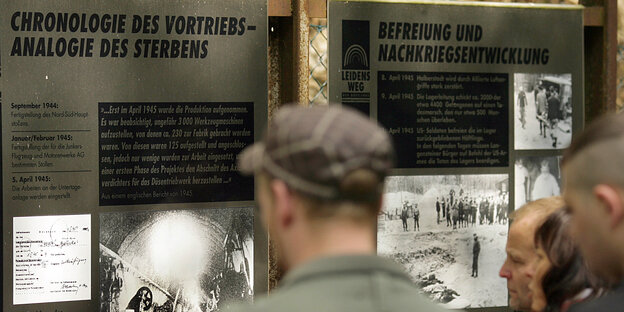The Harz Tourist Association celebrates its 120th anniversary with a chronicle in which the Nazis barely appear. There are no concentration camps and weapons factories.

A monument offers information about the Langenstein-Zwieberge concentration camp in the Harz district; the tourism association omits it Photo: dpa | Jens Lobo
Göttingen taz | Its 120th anniversary is an opportunity for the Harz Tourism Association, as an umbrella organization of municipalities and tourism associations, to take a look at its own history and that of the Harz. In the “Historical Outline” that has just been published, one phase is practically omitted: the period of the Nazi dictatorship from 1933 to 1945.
The starting point for the founding of the association was tourism, which flourished at the beginning of the 20th century, also thanks to the railway. At the suggestion of the ducal bath commissioner Ernst Dommes of Bad Harzburg, representatives of 25 municipalities met in Bad Lauterberg in March 1904 to advertise the Harz, mainly with advertising literature until the First World War. The war years from 1914 to 1918 had as their motto “Healing and Recovery in the Harz.” According to the chronicle, during this time the association had to deal intensively with war-related supply bottlenecks.
After World War I, tourism increased. At the end of the 1920s, the Harz even had regular air connections. In 1928, the Deutsche Lufthansa timetable showed the so-called “Harz Ring”, daily at 15:35 from Hanover via Hildesheim, Goslar, Wernigerode and Quedlinburg to Halle.
There is little in the chronicle about the Nazi era: “One of the special areas of work during this era was the necessary widening of roads,” he says. And: “Since the early 1930s, the association has been governed according to the 'leader principle'.”
This “leader” was the convinced Nazi Dietrich Klagges, who was also Prime Minister of the Free State of Braunschweig. With a decree of August 8, 1936, Klagges ordered the expulsion of the Jews from the Harz Mountains. Within a week, the local NSDAP chiefs and the heads of the seaside administrations would eliminate all freedom of movement in the seaside towns.
Already in 1936 the “leader” of the tourist association ordered the expulsion of all Jews from the Harz.
In a letter, Klagges had already agitated a year earlier: “The strong presence of Jews in the spas, climatic spas, climatic spas and summer resorts gives rise to the suspicion that foreign races see the Harz as a place where Jews can continue without being troubled”.
This is not mentioned in the chronology, as are the munitions factories and subcamps of the concentration camps in the Harz. The secret Kohnstein factory, in present-day Thuringia, was then the largest underground weapons factory in the world. After the Allied attack on Peenemünde and the production of V weapons there, in 1943 it was moved to the edge of the Harz.
At the same time the Mittelbau-Dora concentration camp was built there. Up to 34,000 prisoners had to work in cruel conditions in the mountains. Experts estimate that 20,000 people died.
There were more than 60 weapons factories in the Nordhausen-Bleicherode-Ellrich area alone. According to Goslar geologist Friedhart Knolle, toxins from the explosives filling are still seeping into the groundwater of the “Kiefer plant” in Herzberg, as well as the TNT production plant “Tanne plant” in Clausthal-Zellerfeld. Around 1942, about 2,500 people worked there, including prisoners of war and forced laborers who had to fill the explosive devices with the highly toxic TNT.
The Buchenwald concentration camp also had subcamps in the Harz Mountains. In April 1945, the SS sent more than 40,000 concentration camp prisoners on death marches from there and from Mittelbau-Dora. Four weeks later, at the end of the war, about a quarter of them were dead.
There is nothing about this in the chronicle. Everything starts again afterwards: “After intense debates in the post-war years, in July 1946 the Harz Transport Association (HVV) was founded again for the Lower Saxony part of the Harz and, with it, the revival of tourism”.